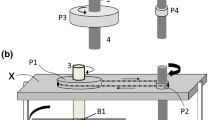Abstract
In this paper, a variable reluctance generator with segmental stator utilizing an assisted DC field for variable speed applications is proposed. In this work, analytical design, magnetic field analysis, and Parametric Sensitivity Analysis of the proposed machine are presented. The stator of suggested configuration, in addition to the distributed phase windings, is included the distributed assisted dc field coils, which are responsible for producing an adjustable magnetic flux in the generator. The segmental stator, the controllability of magnetic flux and generated voltage are the prominent features of the presented generator. Maintenance-free and easy accessibility of each stator segment due to utilizing the segmental stator, and high reliability due to the absence of brush and winding on the rotor is other features of the proposed machine. Finally, the Field Analysis using the finite element method is performed to verify the analytical design and sensitivity analysis. The results obtained from the FE analysis confirm the analytical design and the controllability of magnetic flux and generated voltage for the proposed configuration.

















Similar content being viewed by others
References
Hendershot JR, Miller THE (2010) Design of Brushless Permanent Magnet Machines. Motor Design Books LLC. 30 Mar 2010
Wang Y, Hao W () General topology derivation methods and control strategies of field winding based flux adjustable PM machines for generator system in more electric aircraft. IEEE Trans Transp Electrif . https://doi.org/10.1109/TTE.2020.2997730
Yang C, Lin H, Guo J, Zhu ZQ (2008) Design and analysis of a novel hybrid excitation synchronous machine with asymmetrically stagger permanent magnet. IEEE Trans Magnetics 44(11). November 2008
Tang Y, Paulides JJH, Lomonova EA (2014) Energy conversion in DC excited flux-switching machines. IEEE Trans Magnetics 50(11). Nov 2014
Fukami T, Matsuura Y, Shima K, Momiyama M, Kawamura M (2012) A multipole synchronous machine with no overlapping concentrated armature and field windings on the stator. IEEE Trans Ind Electron 59(6). June 2012
Cheshmehbeigi HM, Afjei E (2013) Design optimization of a homopolar salient-pole brushless DC machine: analysis, simulation, and experimental tests. IEEE Trans Energy Convers 28(2). June 2013
Goodier ERT, Pollock C (2002) Homopolar variable reluctance machine incorporating an axial field coil. IEEE Trans Ind Appl 38(6):1534–1541
Vido L, Gabsi M, Lécrivain M, Amara Y, Chabot F (2005) Homopolar and bipolar hybrid excitation synchronous machines. Proc IEEE IEMDC, TX, pp 1212–1218
Xinghe F, Jibin Z (2009) Numerical analysis on the magnetic field of hybrid exciting synchronous generator. IEEE Trans Magnet 45(10). October 2009
Li J, Wang K (2019) A parallel hybrid excited machine using consequent pole rotor and AC field winding. IEEE Trans Mag 55(6): 1–5. June 2019, Art no. 8101605. https://doi.org/10.1109/TMAG.2019.2893637
Hua H, Zhu ZQ, Zhan H (2016) Novel consequent-pole hybrid excited machine with separated excitation stator. IEEE Trans Industr Electron 63(8):4718–4728. https://doi.org/10.1109/TIE.2016.2559447
Rens J, Jacobs S, Vandenbossche L, Attrazic E (2016) Effect of stator segmentation and manufacturing degradation on the performance of IPM machines, using iCARe® electrical steels. World Electr Veh J 8(2):450–460. https://doi.org/10.3390/wevj8020450
Zhu ZQ et al. (2012) Influence of additional air gaps between stator segments on cogging torque of permanent-magnet machines having modular stators. IEEE Trans Magnetics 48(6). June 2012. https://doi.org/10.1109/TMAG.2011.2179667
Lee C, Krishnan R, Lobo NS (2009) Novel two-phase switched reluctance machine using conunon-pole E-core structure: concept, analysis, and experimental Verifcation. IEEE Trans ind Appl 45(2):703–711
Mao SH, Tsai MC (2005) A novel switched reluctance motor with C-core stators. IEEE Trans Magn 41(12):4413–4420
Szabo L, Ruba M (2012) Segmental stator switched reluctance machine for safety-critical applications. IEEE Trans Ind Appl 48(6):2223–1229. Novl-Dec. 2012.
Kolb J, Hameyer K (2020) Sensitivity analysis of manufacturing tolerances in permanent magnet synchronous machines with stator segmentation. IEEE Trans Energy Convers 35(4):2210–2221. https://doi.org/10.1109/TEC.2020.3017279
Cheng B, Pan G, Mao Z (2020) Analytical calculation and optimization of the segmented-stator dual-rotor axial flux permanent magnet motors. In IEEE Trans Magnetics 56(11): 1–9. Nov. 2020, Art no. 8101709. https://doi.org/10.1109/TMAG.2020.3020589
Ding W, Bian H, Song K, Li Y, Li K (2021) Enhancement of a 12/4 hybrid-excitation switched reluctance machine with both segmented-stator and -rotor. IEEE Trans Industr Electron 68(10):9229–9241. https://doi.org/10.1109/TIE.2020.3021665
Cheng H, Liao S, Yan W (2022) Development and performance analysis of segmented-double-stator switched reluctance machine. IEEE Trans Industr Electron 69(2):1298–1309. https://doi.org/10.1109/TIE.2021.3059554
Ren Z (2002) T-Ω formulation for eddy-current problems in multiply connected regions. IEEE Trans Magn 38:557–560
Webb J (2008) Singular tetrahedral finite elements of high order for scalar magnetic and electric field problems. IEEE Trans Magn 44(6):1186–1189
Magnet CAD Package (2007) User manual. Infolytica Corporation Ltd., Montreal, Canada
Author information
Authors and Affiliations
Corresponding author
Additional information
Publisher's Note
Springer Nature remains neutral with regard to jurisdictional claims in published maps and institutional affiliations.
Rights and permissions
Springer Nature or its licensor (e.g. a society or other partner) holds exclusive rights to this article under a publishing agreement with the author(s) or other rightsholder(s); author self-archiving of the accepted manuscript version of this article is solely governed by the terms of such publishing agreement and applicable law.
About this article
Cite this article
Bibak, S.H., Moradi CheshmehBeigi, H. & Karimi, S. DC field-assisted generator with flux control capability for direct drive and variable speed applications. Electr Eng 105, 619–631 (2023). https://doi.org/10.1007/s00202-022-01684-4
Received:
Accepted:
Published:
Issue Date:
DOI: https://doi.org/10.1007/s00202-022-01684-4




